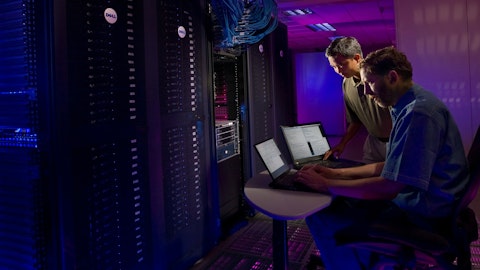Mike Cikos: I appreciate the color, Matt. And I really appreciate the transparency there as well. I just wanted to be crystal clear then when we turn to the outlook, again, it seems like you guys are juggling a number of different pieces all in real time. But as far as those assumptions that you have is — I don’t want to characterize but like between churn contraction and expansion, what are the assumptions that you’re embedding in your guidance today which gives you confidence in your ability to achieve the numbers that we’re communicating to the Street investors?
Matt Steinfort: I’d say we’re assuming that nothing gets better than what we’re currently seeing. So the rates have declined and the level that we’re landing on the things that stabilized. Stay the same. We don’t see an improvement in any of those which would imply we’re not forecasting a bottom in our guidance.
Mike Cikos: That’s great. That’s exactly 1 other 1 in to clear up with my understanding.
Operator: Your next question comes from the line of Pinjalim Bora with JPMorgan.
Pinjalim Bora: Yancey, can you talk a little bit more about Paperspace. Can you talk about maybe the customers that Paperspace brings to the table some of the use cases, those customers are working on. And as I look at the numbers, I think you’re saying $5 million for the second half. So call it, $10 million, $10 million, $12 million for the year, 12,000 customers. So is it something like $1,000 ACV about. Help me understand through that. And then lastly, what portion of Paperspace’s customers are on the ML Ops platform versus kind of the core infrastructure?
Yancey Spruill: I think we’ll provide more detail around some of that as we sort through some of the analytics on the business in terms of the mix, etcetera at a subsequent call. What I would say is their customers are very similar to ours. They’re small emerging startups, many names you would have never heard of. Similar to our customer base from all over the place. Lots of different use cases. Obviously, language models is a big growth driver in the near term. Generative Media is a very interesting one, a very dynamic advertising, media, video etcetera, based upon whatever the vertical or use case. So that’s a lot of people taking a lot of data and leveraging that for outcomes and is very exciting. What I learned about it is that the fact is you can look at the logos, you can look at the names in terms of the customers.
And like our business, it’s long tail. It’s — we enable people all over the planet to leverage their ideas in the cloud. And now we have the ability to do that in AI/ML. And so I think the ARPU is higher. Then I think our average customer will give more specifics later than that. And it’s — that’s what we said earlier. It’s a really hand in glove fit in so many dimensions. And — and I think I’m excited to get this in the hands of our DigitalOcean customers and vice versa to give the Paperspace customers the same — similar kind of experience they’ve had building their AI apps once they get those over the hump and are running a business around that application that can run on our platform and have the same experience in terms of ease-of-use, simplicity, the support model or community investment and the low cost.
Operator: Your next question comes from the line of Jim Fish with Piper Sandler.
Quinton Gabrielli: This is Quinton on for Jim Fish. Yancey, maybe first for you. I’d like to touch a little bit on the time line side of coming to this Paperspace deal. Thinking back to Q3, Q4, we talked a little bit about how CPUs would be able to support AI workloads. And then kind of Q1, we transitioned to GPUs are probably an attractive expansion to the platform. And then obviously, now we have the Paperspace offering. Can you talk through what trends or maybe inputs changed from Q3, Q4 to Q1, Q2, where now you know you need this kind of GPU as a service offering? And then any color you can provide around the acquisition process of Paperspace, whether it was competitive bidding or anything would be helpful.
Yancey Spruill: Yes. So I don’t know that we never — we ever said. I ever said that we didn’t need GPUs. What I think we were clarifying is that there were a number of AI-based algorithmic type business models that we’re running on our platform because high-performance compute was fine. I think that tended to be more in the inference market versus the language model market. So I just want to be clear. We have always said that we wanted to build a GPU capability and AI/ML platform capability, certainly since we’ve been public. We’ve known Paperspace for years. I’ve stayed very close to the founders since I became CEO in 2019. So we’re excited to, let’s say, finally have them part of the DigitalOcean family. But we certainly saw with late last year, early this year, a pickup in the threshold level of capability and market perception and interest in the language model opportunity which the market wants to use GPUs for those, certainly, to get the model up and running, maybe not to operate the model once it is running in customers’ hands, certainly, the level of compute needs change and we’ll see how that plays out.



